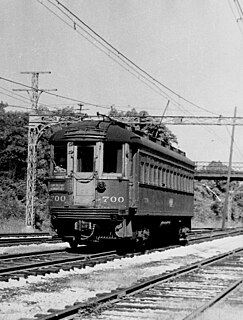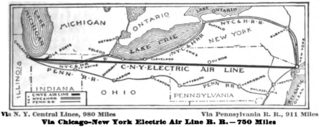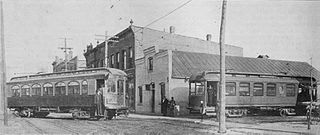Related Research Articles

The Interurban is a type of electric railway, with streetcar-like electric self-propelled rail cars which run within and between cities or towns. They were very prevalent in North America between 1900 and 1925 and were used primarily for passenger travel between cities and their surrounding suburban and rural communities. Interurban as a term encompassed the companies, their infrastructure, their cars that ran on the rails, and their service. In the United States, the early 1900s Interurban was a valuable economic institution. Most between town roads and many town streets were unpaved. Transportation and haulage was by horse-drawn carriages and carts. The Interurban provided a new particularly in winter weather reliable transportation link between the town and countryside. In 1915, 15,500 miles (24,900 km) of interurban railways were operating in the United States and, for a few years, interurban railways, including the numerous manufacturers of cars and equipment, were the fifth-largest industry in the country. By 1930, most interurbans in North America were gone with a few surviving into the 1950s. Oliver Jensen, author of American Heritage History of Railroads in America, commented that "...the automobile doomed the interurban whose private tax paying tracks could never compete with the highways that a generous government provided for the motorist."

The Cincinnati and Lake Erie Railroad (C&LE) was a short-lived electric interurban railway that operated in 1930–1939 Depression-era Ohio and ran between the major cities of Cincinnati, Dayton, Springfield, Columbus, and Toledo. It had a substantial freight business and interchanged with other interurbans to serve Detroit and Cleveland. Its twenty high-speed "Red Devil" interurban passenger cars operated daily between Cincinnati and Cleveland via Toledo, the longest same equipment run by an interurban in the United States. The C&LE failed because of the weak economy and the loss of essential freight interchange partners. It ceased operating in 1939.

The Rochester Industrial and Rapid Transit Railway, more commonly known as the Rochester subway was a light rail rapid transit line in the city of Rochester, New York, from 1927 to 1956. The subway was constructed in the bed of the old Erie Canal, which allowed the route to be grade-separated for its entire length. Two miles (3.2 km) of the route through downtown were constructed in a cut-and-cover tunnel that became Broad Street, and the only underground portion of the subway. The Rochester Subway was designed to reduce interurban traffic on city streets, and to facilitate freight interchange between the railroads. The line was operated on a contract basis by New York State Railways until Rochester Transit Corporation (RTC) took over in 1938. The last day of passenger service was June 30, 1956. Portions of the right-of-way were used for expressway construction, while the rest was abandoned and filled in over the years. The largest remaining section is a stretch of tunnel under Broad Street from Exchange Street to the intersection of Court Street and South Avenue.

New York State Railways was a subsidiary of the New York Central Railroad that controlled several large city streetcar and electric interurban systems in upstate New York. It included the city transit lines in Rochester, Syracuse, Utica, Oneida and Rome, plus various interurban lines connecting those cities. New York State Railways also held a 50% interest in the Schenectady Railway Company, but it remained a separate independent operation. The New York Central took control of the Rochester Railway Company, the Rochester and Eastern Rapid Railway and the Rochester and Sodus Bay Railway in 1905, and the Mohawk Valley Company was formed by the railroad to manage these new acquisitions. New York State Railways was formed in 1909 when the properties controlled by the Mohawk Valley Company were merged. In 1912 it added the Rochester and Suburban Railway, the Syracuse Rapid Transit Railway, the Oneida Railway, and the Utica and Mohawk Valley Railway. The New York Central Railroad was interested in acquiring these lines in an effort to control the competition and to gain control of the lucrative electric utility companies that were behind many of these streetcar and interurban railways. Ridership across the system dropped through the 1920s as operating costs continued to rise, coupled with competition from better highways and private automobile use. New York Central sold New York State Railways in 1928 to a consortium led by investor E. L. Phillips, who was looking to gain control of the upstate utilities. Phillips sold his stake to Associated Gas & Electric in 1929, and the new owners allowed the railway bonds to default. New York State Railways entered receivership on December 30, 1929. The company emerged from receivership in 1934, and local operations were sold off to new private operators between 1938 and 1948.

The Chicago North Shore and Milwaukee Railroad, also known as the North Shore Line, was an interurban that operated between the Chicago Loop and downtown Milwaukee. The 85-mile (137 km) route of the North Shore Line utilized a combination of private rights-of-way and street running as well as trackage rights over the Chicago "L" network. In addition to operating passenger and freight trains, the company also provided streetcar and motor bus services throughout its history.

The Chicago Aurora and Elgin Railroad (CA&E), known colloquially as the "Roarin' Elgin" or the "Great Third Rail", was an interurban railroad that operated passenger and freight service on its line between Chicago and Aurora, Batavia, Geneva, St. Charles, and Elgin, Illinois. The railroad also operated a small branch to Mt. Carmel Cemetery in Hillside and owned a branch line to Westchester.

The Chicago – New York Electric Air Line Railroad (CNY) was a proposed high-speed electric air-line railroad between Chicago and New York City. At roughly 750 miles (1,210 km) it would have been over 150 miles (240 km) shorter than the two primary steam railroads on that route, the New York Central Railroad and Pennsylvania Railroad. The promoters' vision proved wildly optimistic and, in the end, only a short interurban route in the vicinity of Gary, Indiana was built and operated. It was the most ambitious of several such proposals at the dawn of electric railroading, all of which ended in failure.

The Illinois Terminal Railroad Company, known as the Illinois Traction System until 1937, was a heavy duty interurban electric railroad with extensive passenger and freight business in central and southern Illinois from 1896 to 1956. When Depression era Illinois Traction was in financial distress and had to reorganize, the Illinois Terminal name was adopted to reflect the line's primary money making role as a freight interchange link to major steam railroads at its terminal ends, Peoria, Danville, and St. Louis. Interurban passenger service slowly was reduced, and it ended in 1956. Freight operation continued but was hobbled by tight street running in some towns requiring very sharp radius turns. In 1956, ITC was absorbed by a consortium of connecting railroads.

The Elgin and Belvidere Electric Company was a 36-mile (58 km) interurban line that connected Belvidere, Illinois and Elgin, Illinois. It was the central link in the interurban network connecting Freeport, Rockford, Elgin, and Chicago which included the Rockford and Interurban Railway to the west and the Chicago, Aurora and Elgin Railroad to the east. The line was operational from 1907 until 1930. In 1927, the line was extended to Rockford over a line of the Rockford and Interurban.
The Indiana Railroad (IR) was the last of the typical Midwestern United States interurban lines. It was formed in 1930-31 by combining the operations of the five major interurban systems in central Indiana into one entity. The predecessor companies came under the control of Midland Utilities, owned by Samuel Insull. It was Insull's plan to transform the Indiana interurban network into a new Indiana Railroad by modernizing the profitable routes and abandoning the unprofitable ones. With the onset of the Great Depression, the Insull empire collapsed and the Indiana Railroad was left with a decaying infrastructure and little hope for overcoming the growing competition of the automobile for passenger business and the truck for freight business. The IR faced bankruptcy in 1933, and receiver Bowman Elder was designated to run the company. Payments on bonded debt were suspended. Elder was able to keep the system virtually intact for four years, and IR operated about 600 miles (970 km) of interurban lines throughout Indiana during this period. During the late 1930s, the routes were abandoned one by one until a 1941 wreck with fatalities south of Indianapolis put an abrupt end to the last operation of interurbans in Indiana.

The San Francisco, Napa and Calistoga Railway, later briefly reorganized as the San Francisco and Napa Valley Railroad, was an electric interurban railroad in the U.S. state of California.

The Interurban Bridge, also known as the Ohio Electric Railroad Bridge. is a historic interurban railway reinforced concrete multiple arch bridge built in 1908 to span the Maumee River joining Lucas and Wood counties near Waterville, Ohio. The span was once the world's largest earth-filled reinforced concrete bridge.One of the bridge's supports rests on the Roche de Boeuf, a historic Indian council rock, which was partially destroyed by the bridge's construction. The bridge, which is no longer in use, is a popular subject for photographers and painters, who view it from Farnsworth Metropark.

The Southern Pacific Red Electric Lines, also known simply as the Red Electric, was a network of interurban passenger train services operated by the Southern Pacific Railroad in the Willamette Valley of the U.S. state of Oregon from 1914 to 1929. The service got its name from the bright red color of its cars. Despite its short history, among West Coast interurbans it was unique, and it was considered the finest such system in the Pacific Northwest. It was the only major electric interurban railroad converted from steam to electric passenger use. It was also one of few systems using all-steel equipment, and one of the largest 1500-volt systems in the country.
The Rochester and Syracuse Railroad was a double-track, high-speed line 87 miles (140 km) long that ran between Rochester and Syracuse, New York. The tracks paralleled the New York Central Railroad and the Erie Canal and had only one grade crossing with another railroad its entire length.
The Rochester Railway Company operated a streetcar transit system throughout the city of Rochester from 1890 until its acquisition by Rochester Transit Corp. in 1938. Formed by a group of Pittsburgh investors, the Rochester Railway Company purchased the Rochester City & Brighton Railroad in 1890, followed by a lease of the Rochester Electric Railway in 1894. The Rochester and Suburban Railway was leased in 1905, extending the system's reach to Irondequoit and Sea Breeze. Rochester Railways was acquired by the Mohawk Valley Company, a subsidiary of the New York Central Railroad set up to take control of electric railways in its territory. In 1909 the holdings of the Mohawk Valley Company were consolidated as the New York State Railways.
Chartered in 1886, the Canandaigua Street Railroad was a local streetcar line serving the lakeside city of Canandaigua, New York beginning in 1887. The railroad was sold to the Canandaigua Electric Light and Railroad which rebuilt and electrified the line in 1892. The Ontario Light and Traction Company purchased it in 1900, and leased the line to the Rochester and Eastern Rapid Railway in 1903. In 1905, the line came under the control of the Mohawk Valley Company, and in turn, New York State Railways in 1909. Operation was converted to bus operation some time in the 1920s, but this service ended when the Rochester and Eastern Rapid Railway shut down on July 31, 1930. The lease of the former Canandaiua lines was allowed to lapse.

The Rochester and Eastern Rapid Railway (R&ER) was an electric interurban railway in New York State, USA, connecting Rochester, Canandaigua, and Geneva.
The Aurora, Plainfield and Joliet was a 22-mile (35 km) interurban railroad which operated between its namesake cities of Aurora, Illinois, Plainfield and Joliet in northern Illinois from October 21, 1904 to 1924.
References
- 1 2 3 "Trolleys and Interurbans, Classic American Streetcars". American-Rails.com. 2007–2017. Retrieved August 19, 2017.
- 1 2 "Interurban Railways in Illinois". Chicago Transit & Railfan. 2007–2017. Retrieved August 19, 2017.
- 1 2 "Electric Railways". Electrical Review and Western Electrician. 61 (12): 570–571. September 21, 1912. Retrieved August 19, 2017.
- ↑ Biennial Report of the Secretary of State of the State of Illinois. Springfield, Illinois: Illinois Secretary of State. 1912. p. 87.